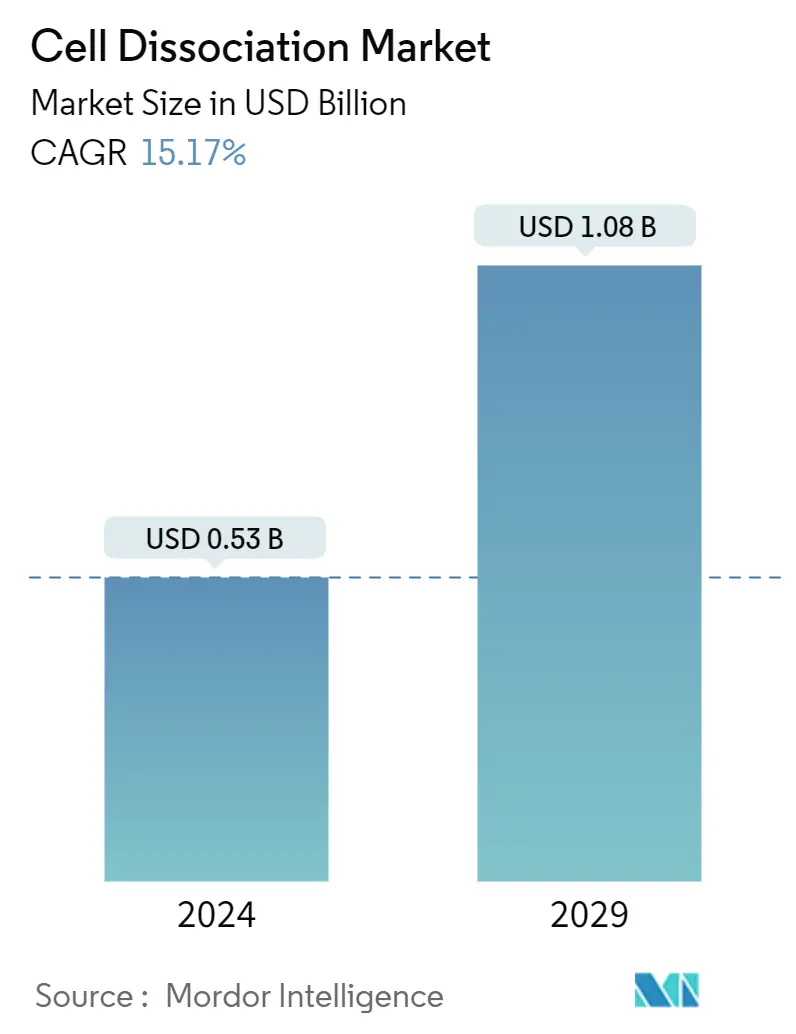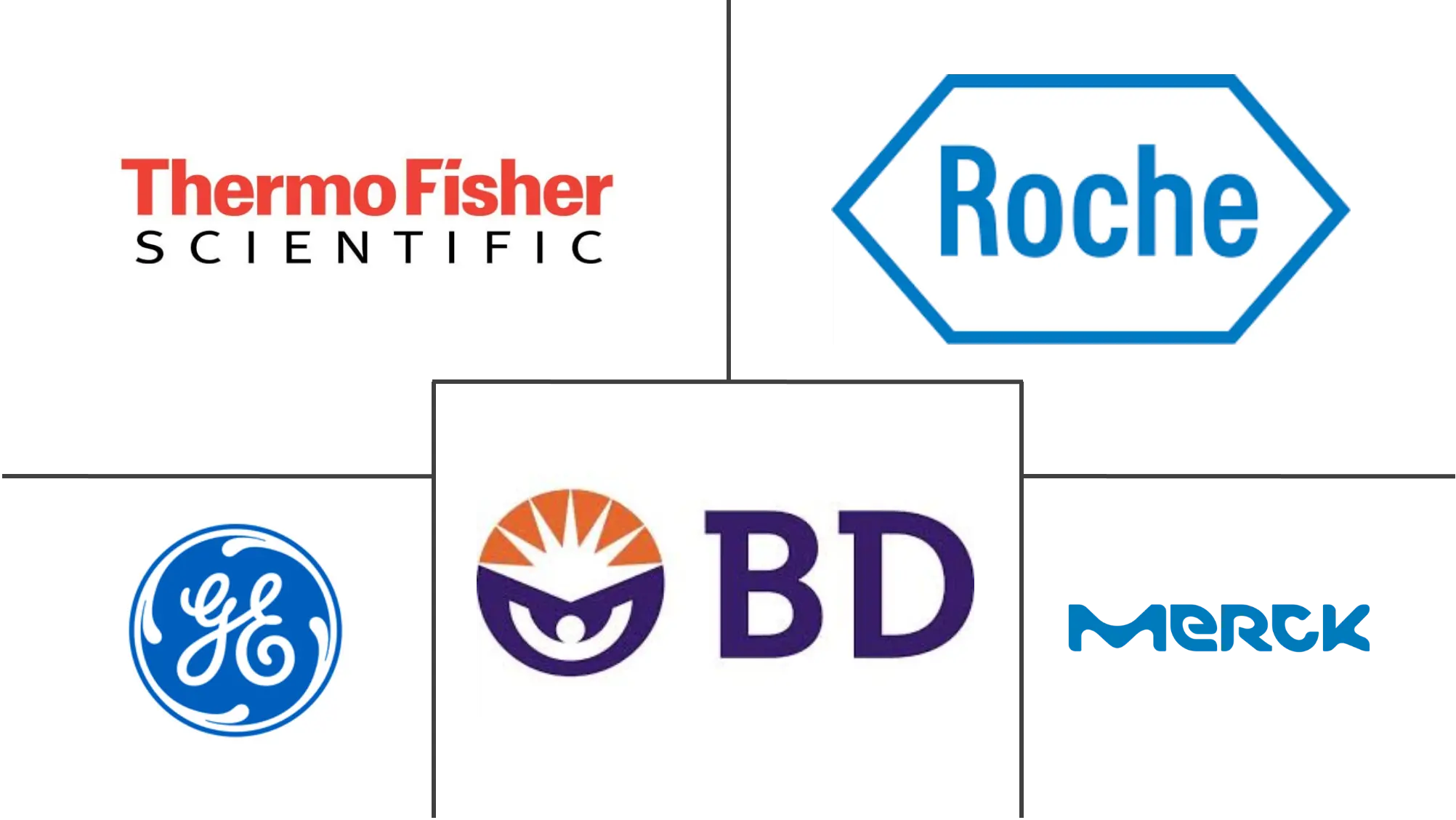Market Size of Cell Dissociation Industry

| Study Period | 2019 - 2029 |
| Market Size (2024) | USD 0.53 Billion |
| Market Size (2029) | USD 1.08 Billion |
| CAGR (2024 - 2029) | 15.17 % |
| Fastest Growing Market | Asia Pacific |
| Largest Market | North America |
Major Players
*Disclaimer: Major Players sorted in no particular order |
Cell Dissociation Market Analysis
The Cell Dissociation Market size is estimated at USD 0.53 billion in 2024, and is expected to reach USD 1.08 billion by 2029, growing at a CAGR of 15.17% during the forecast period (2024-2029).
Key drivers fueling market growth include increasing R&D initiatives in biopharmaceutical firms and a global uptick in cancer research funding.
The surge in R&D outlays within the biopharmaceutical sector has been a linchpin in the market's expansion. According to the European Federation of Pharmaceutical Industries and Associations' 2024 report, European pharmaceutical entities allocated EUR 47.01 billion (USD 49.43 billion) in 2022, which was expected to increase to EUR 50 billion (USD 54.11 billion) in 2023.
Several firms are channeling investments into biopharmaceutical R&D. In September 2022, Marinus Pharmaceuticals secured a significant contract option from the Biomedical Advanced Research and Development Authority (BARDA) worth around USD 12.3 million. This move aimed to bolster the manufacturing capabilities of ganaxolone.
Major market players are ramping up their investments in biologics R&D, intensifying the quest for novel biologics. In September 2022, Novartis delved into next-gen biotherapeutics, fortifying its biologics manufacturing and development arm. With such robust R&D commitments, the market is poised for substantial growth in the near future.
Product launches by market players are also pivotal in driving market expansion. For instance, in February 2023, LevitasBio Inc. rolled out its LeviSelect cell depletion and enrichment kits tailored for immunology research.
The market's growth trajectory, bolstered by escalating R&D investments and new product launches, is promising. However, the market may face a hurdle in the form of the high costs associated with tissue- and cell-based procedures.
Cell Dissociation Industry Segmentation
Cell dissociation refers to the act of separating adherent cell monolayers into single-cell suspensions. The cell dissociation process has tremendous application in regenerative medicine and stem cell research. The cell dissociation products are either enzyme-based or non-enzymatic buffers.
The cell dissociation market is segmented by product, tissue, end user, and geography. By product, the market is sub-segmented into enzymatic dissociation products, non-enzymatic dissociation products, instruments, and accessories. By tissue, the market is sub-segmented into connective tissue, epithelial tissue, and other tissues. By end user, the market is sub-segmented into pharmaceutical and biotechnology companies, research and academic institutes, and other end users. By geography, the market is sub-segmented into North America, Europe, Asia-Pacific, Middle East and Africa, and South America. The report also covers the estimated market sizes and trends for 17 different countries across major regions globally. The report offers the value (USD) for all the above segments.
| By Product | |
| Enzymatic Dissociation Products | |
| Non-enzymatic Dissociation Products | |
| Instruments and Accessories |
| By Tissue | |
| Connective Tissue | |
| Epithelial Tissue | |
| Other Tissues |
| By End-User | |
| Pharmaceutical and Biotechnology Companies | |
| Research and Academic Institutes | |
| Other End-Users |
| Geography | ||||||||
| ||||||||
| ||||||||
| ||||||||
| ||||||||
|
Cell Dissociation Market Size Summary
The cell dissociation market is experiencing robust growth, driven by increased research and development activities within the biopharmaceutical sector and a global rise in cancer research funding. The market's expansion is significantly supported by substantial investments in biologics research and development, with major players like Novartis and Marinus Pharmaceuticals enhancing their capabilities in this domain. The introduction of new products, such as LevitasBio Inc.'s LeviSelect cell depletion and enrichment kits, further propels market growth. However, the high costs associated with tissue- and cell-based procedures present a challenge. The demand for cell dissociation products is also fueled by the pharmaceutical and biopharmaceutical industries' focus on new drug development and the emergence of contract development manufacturing organizations (CDMOs) to streamline biopharmaceutical production.
North America is poised for significant growth in the cell dissociation market, supported by its advanced biopharmaceutical industry and increased investments in novel therapies. The region's market expansion is further bolstered by the rising incidence of chronic diseases, such as cancer and cardiovascular diseases, and the growing geriatric population. The establishment of new cell-related manufacturing and research facilities, like REPROCELL's GMP Manufacturing Facility for Stem Cells in the US, underscores the market's upward trajectory. The market is semi-consolidated, with intense competition among local and international players, particularly in North America and Europe. Companies are also expanding their presence in regions like India, as seen with Miltenyi Biotec's establishment of a Cell and Gene Therapy Centre of Excellence.
Cell Dissociation Market Size - Table of Contents
-
1. MARKET DYNAMICS
-
1.1 Market Overview
-
1.2 Market Drivers
-
1.2.1 Increasing R&D Activities in Biopharmaceutical Companies
-
1.2.2 Favourable Funding Scenario for Cancer Research
-
-
1.3 Market Restraints
-
1.3.1 High cost of Tissue- and Cell-based Procedures
-
-
1.4 Porter's Five Forces Analysis
-
1.4.1 Bargaining Power of Buyers/Consumers
-
1.4.2 Bargaining Power of Suppliers
-
1.4.3 Threat of New Entrants
-
1.4.4 Threat of Substitute Products
-
1.4.5 Intensity of Competitive Rivalry
-
-
-
2. MARKET SEGMENTATION
-
2.1 By Product
-
2.1.1 Enzymatic Dissociation Products
-
2.1.2 Non-enzymatic Dissociation Products
-
2.1.3 Instruments and Accessories
-
-
2.2 By Tissue
-
2.2.1 Connective Tissue
-
2.2.2 Epithelial Tissue
-
2.2.3 Other Tissues
-
-
2.3 By End-User
-
2.3.1 Pharmaceutical and Biotechnology Companies
-
2.3.2 Research and Academic Institutes
-
2.3.3 Other End-Users
-
-
2.4 Geography
-
2.4.1 North America
-
2.4.1.1 United States
-
2.4.1.2 Canada
-
2.4.1.3 Mexico
-
-
2.4.2 Europe
-
2.4.2.1 Germany
-
2.4.2.2 United Kingdom
-
2.4.2.3 France
-
2.4.2.4 Italy
-
2.4.2.5 Spain
-
2.4.2.6 Rest of Europe
-
-
2.4.3 Asia-Pacific
-
2.4.3.1 China
-
2.4.3.2 Japan
-
2.4.3.3 India
-
2.4.3.4 Australia
-
2.4.3.5 South Korea
-
2.4.3.6 Rest of Asia-Pacific
-
-
2.4.4 Middle East and Africa
-
2.4.4.1 GCC
-
2.4.4.2 South Africa
-
2.4.4.3 Rest of Middle East and Africa
-
-
2.4.5 South America
-
2.4.5.1 Brazil
-
2.4.5.2 Argentina
-
2.4.5.3 Rest of South America
-
-
-
Cell Dissociation Market Size FAQs
How big is the Cell Dissociation Market?
The Cell Dissociation Market size is expected to reach USD 0.53 billion in 2024 and grow at a CAGR of 15.17% to reach USD 1.08 billion by 2029.
What is the current Cell Dissociation Market size?
In 2024, the Cell Dissociation Market size is expected to reach USD 0.53 billion.

